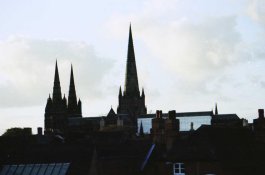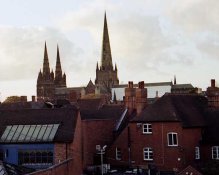And I disagree about the utility of the histogram...if you had a scene with shadowy area under the trees, some of the scene is the building, and some of the scene is sky, the histogram tells you nothing about the pixels specifically which make up the building! You know the quantity of dark, medium and light pixels, whether too many of them seem to be falling off the histogram, but nothing about the suitability of the pixels that are rendering the main object of interest (whatever that might be!)
But this is an analog forum, so the debate about histogram is pointless!

The particular questions you ask of the histogram are irrelevent because you want to transpose the functionality of a meter to the histogram, and it's apples and oranges. You want to know where the leaves or Sally's face are on the histogram, and well, there are far better questions to ask of a histogram, frankly.
When you look at the histogram, the far left are the darkest part of your composition (for example the patch of dirt your cute wife is posing on), and the highlights on the far right are (for example the patches of over cast skys in your composition). That is really all you need to know because everything in the middle often can safely be shifted up or down via EC. It's the extreme left (shadows) and extreme right (highlights) that could get sacrificed.
So don't try to use a light meter in the same way you might read a histogram, and once you figure this out, you too will find that the histogram gives better "advice" then a light meter.
Another way to look at this is that a light meter will tell you a reading based on what you decide is 18% gray, and that is it. The histogram shows the amount of distribution at 18% (middle) and for the entire dynamic range..far more helpful to a digital photographer.
I've yet to come across a composition that could not be exposed correctly without a hand held meter.
On the other hand, i readly see the value of a handheld meter for shooting film, and for this reason I use one from time to time but only when I shoot film.














